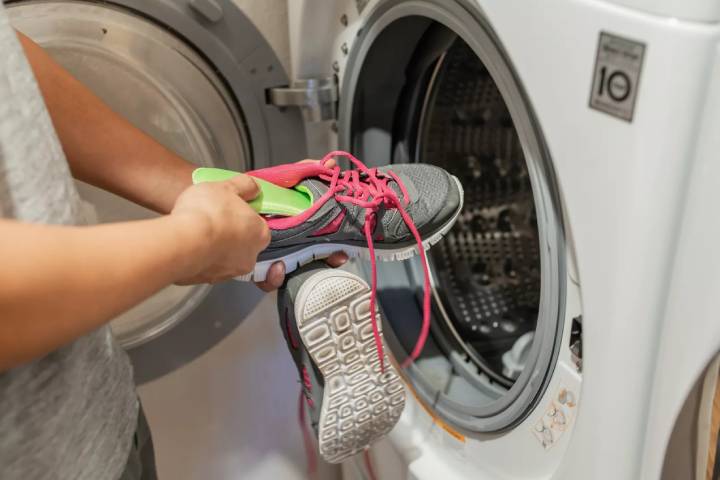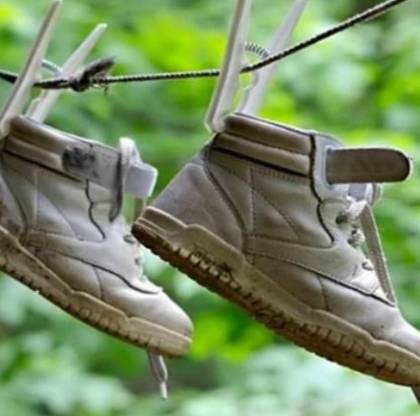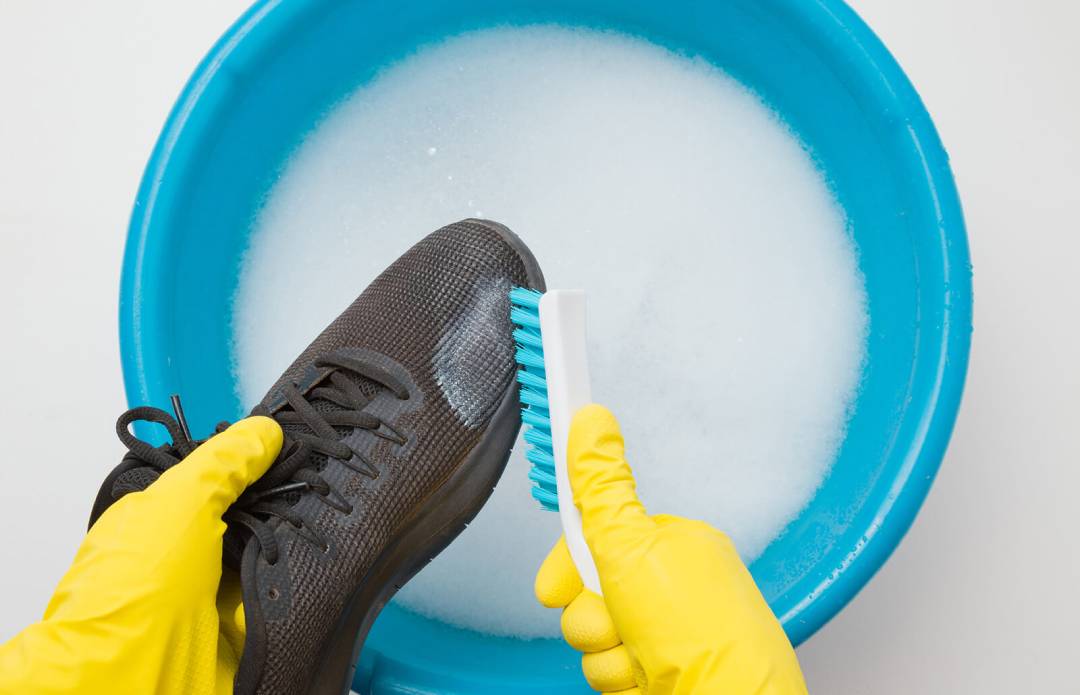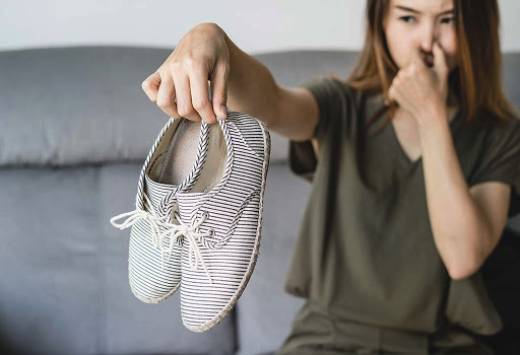
Nothing is better than finding used shoes in good condition. Not only is it a great way to save money but finding vintage shoes that are rare and fashionable is cool. However, if you are buying used shoes, it is is more important to know how to sanitize used shoe.
This is because used shoes may contain fungi, bacteria, or viruses that can be transferred to your feet when you put them on.
So it is recommended to disinfect before trying on new shoes, even if they’re in good condition. You don’t know where they were before. This article explains how to disinfect used shoes in an effective manner.
BEFORE BUYING A USED SHOE
If you’re planning on buying used shoes, there are a few things to consider. First, you need to make sure that the shoes you buy don’t fray too much. You also need to check the soles. If possible, the outsole should be clean and not worn.
There should be no foot-shaped pattern on the insole of the shoe. Also, do not buy thrift store shoes if the instep is worn or severely wrinkled.
Things to look at before buying used shoes
There are a few things to look at before you take your used shoes out of the store. This makes cleaning used shoes easier. Below are some tips to keep your used shoes clean inside and out so that you always feel better.
There are many hacks mentioned below on how to clean second hand shoes. But before exploring them, if you are given the situation to handle used shoes that have fungus in this, you can make use of the below given tips.
HOW LONG DOES FUNGUS LIVE IN SHOES?

Unfortunately, the fungus can remain on the shoe cloth for a few months. Some bacteria tend to cause a rash on the skin. These bacteria, known as dermatophytes, feed on most keratins.
Keratin is an essential protein found in hair, dead skin, and nails. That means there’s a good chance the mold is still alive on the used shoes you bought.
Another type of virus seen on thrift store shoes is the papillomavirus, which tends to cause plantar warts. In most cases, the virus can only pass through damaged skin.
So clean your shoes properly before putting them on.
How to get fungus out of your shoes?
Germs are everywhere, including in shoes. You can even find bacteria in your new shoes. Well, don’t be afraid to buy used shoes, just disinfect used shoes before wearing them. An unconventional answer to how to clean second-hand shoes is by using light. UV is great for killing mold.
Shoe disinfection devices that emit ultraviolet light to disinfect and deodorize shoes are on the market.
HOW TO SANITIZE USED SHOES
When buying for the first time, cleaning used shoes is essential to restore their freshness. Depending on the age and usage of the shoe, there may be slight scratches or traces of dirt.
Hence, you may use the following tips and tricks on how to disinfect used shoes.

Using rubbing alcohol:
Using bleach:
Bleach is a powerful disinfectant. Never apply bleach directly to your shoes. Always mix with water first. Bleach can damage bright colors and leather, but you can spray inside. Mix a small amount of bleach with plenty of water and place in a spray bottle. Mist the inside of the shoe to dry it. This is an effective way to disinfect used shoes.
Antibacterial spray:
An alternate method on how to disinfect used shoes but with safe products, you can cover the sole with an antifungal product such as a spray used for avoiding athlete’s foot. If the material is porous, spray the boot disinfectant spray on the outside of the shoe as well. Spray boot disinfectant spray to clean second-hand shoes and dry them before wearing them.
HOW TO CLEAN USED SHOES
Just knowing how to sanitize used shoes is not enough. The above tactics can kill bacteria or viruses, but they won’t completely clean your shoes. Try these methods of deep cleansing to remove dirt and contaminants. This works really well if you want to know how to clean second-hand shoes.
Thus, make sure your pants fit perfectly and are longer than your usual height. This way, you would get perfect bloused boots.
HOW TO GET RID OF SMELLY SHOES
You can be tempted to hide the odor. However, if you do not kill the bacteria, the stench will reappear. Therefore, only after cleaning used shoes and using boot disinfectant spray, try the following methods.

Using baking soda: Baking soda can be your stinky shoe’s best friend. Sprinkle on your shoes and put them in a plastic bag overnight. In the morning, pay the dust from baking soda. You may need to sprinkle baking soda all over the shoe, not just the insoles.
Vinegar: You can wash the insole of the used shoes with a solution of water and vinegar. Mix equal amounts of water and white vinegar. Turn that mixture as much as possible to sink the insole. Rinse with clean tap water. Don’t worry, and when the insole is dry, it won’t smell like vinegar.
Using alcohol: If you don’t mind the smell of your second-hand shoes with baking soda and vinegar, you can try the alcohol method. Soaking the shoe in alcohol allows the chemical to penetrate the deepest pores of the shoe. This strategy can get rid of strong odors that remain for several years.
Dryer sheets: Dryer sheets can infuse your shoes with a pleasant smell, giving them a fresh smell. To use this method, place two dryer sheets on the inside of each shoe. You can even put them in a plastic bag for better odor removal behavior. Remove the dryer sheet before putting on shoes.
Freezer: A weird method, but it inactivates bacteria. So, taking your shoes off in a cold environment can smell fresh, but they can immediately smell when you put them on. Also, you probably don’t want to have dirty shoes worn by other people close to frozen food.
Tea tree oil: Tea tree oil or any other essential oil with antibacterial and antifungal properties. Mix a few drops with water. Next, spray and dry the inside of the shoe. Do as much work as necessary to kill odors.
Also check,
FREQUENTLY ASKED QUESTIONS
1. How to clean thrift store shoes?
Wipe the inside and outside of the shoe with a damp cloth. Take 20 drops of tea tree oil and rubbing alcohol. Tea tree oil has antibacterial, antiviral, antifungal, and anti-inflammatory properties and is ideal for disinfecting second-hand shoes. Inject the mixture inside and outside the shoe. Keep it dry.
2. How To Disinfect Shoes From The Thrift Store?
After cleaning used shoes, you can disinfect used shoes with antibacterial or antifungal spray. Use a Lysol spray or mix a glass of bleach with water in a spray bottle. Apply to the entire inside of the shoe and let it dry.
3. How To Clean Used Shoes bought online?
1. By using boot disinfectant spray and then cleaning them with Clorox wet wipes/bleach/alcohol etc.
2. Apply to the inside and outside and let it dry.
4. Can You Spray Lysol On Shoes?
1. Use a Lysol spray or mix a glass of bleach with water in a spray bottle.
2. Apply to the entire inside of the shoe and let it dry.
5. Does Clorox Wipe Helps To Clean Shoes?
Contrary to common belief, Clorox wet wipes do not contain chlorine bleach. Therefore, it is ideal when you renew your used shoes. Wipe the inside and outside of the shoes well. Consumers wipe their sneakers, especially with Clorox wet wipes.
6. What Do Bowling Alleys Use To Disinfect The Shoes?
Bowling alleys’ disinfection methods for shoes vary from location to preference. Most bowling alleys ideally use anti-fungal sprays and talc-free powders during use.
CONCLUSION
As cool as buying old, vintage shoes can be, they can also harm you. Even though they are easy on the pocket, they can breed your feet with harmful bacteria and fungus. Hence, it is extremely important to know how to sanitize used shoes.
There are several methods to use in order to clean your old-but-new pairs, and you can choose any as per your liking. Just remember to disinfect, and then wear them as much as you like! Happy Responsible Shopping!
Justin is a Master Fitness Trainer, coach, and consultant. Justin holds Science degrees in biological science, natural life science, and human anatomy focus. He has been assisting as a Fitness trainer for over 15 years in the health and fitness industry. He enjoys teaching others to achieve their goals and wellness using his expertise.


